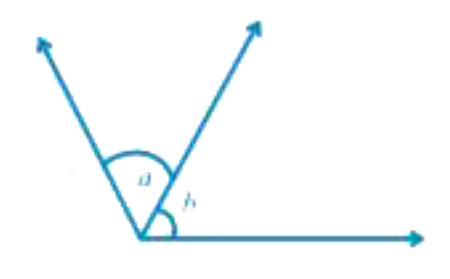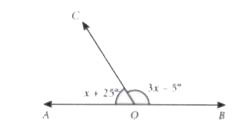In which of the following figures, a and b are forming a pair of adjacent angles?




To determine which of the given figures shows angles A and B as a pair of adjacent angles, we need to follow these steps:
1. Understand the Definition of Adjacent Angles:
- Adjacent angles are two angles that share a common vertex and a common side, and do not overlap in their interior points.
2. Analyze Each Option:
- We will examine each of the four options provided to see if they meet the criteria for adjacent angles.
3. Check Option 1:
- In Option 1, identify the angles A and B.
- Check if they share a common vertex and a common side.
- Conclusion: They do not share a common side, so they are not adjacent angles.
4. Check Option 2:
- In Option 2, identify the angles A and B.
- Check if they share a common vertex and a common side.
- Conclusion: The vertices are different, so they are not adjacent angles.
5. Check Option 3:
- In Option 3, identify angles A and B.
- Check if they share a common vertex and a common side.
- Conclusion: Although they share a common vertex and a common side, they overlap in their interior points, so they are not adjacent angles.
6. Check Option 4:
- In Option 4, identify angles A and B.
- Check if they share a common vertex and a common side.
- Conclusion: They share a common vertex and a common side, and there are no overlapping interior points. Thus, they are adjacent angles.
7. Final Answer:
- The correct option where angles A and B form a pair of adjacent angles is Option 4.
- Adjacent angles are two angles that share a common vertex and a common side, and do not overlap in their interior points.
- We will examine each of the four options provided to see if they meet the criteria for adjacent angles.
- In Option 1, identify the angles A and B.
- Check if they share a common vertex and a common side.
- Conclusion: They do not share a common side, so they are not adjacent angles.
- In Option 2, identify the angles A and B.
- Check if they share a common vertex and a common side.
- Conclusion: The vertices are different, so they are not adjacent angles.
- In Option 3, identify angles A and B.
- Check if they share a common vertex and a common side.
- Conclusion: Although they share a common vertex and a common side, they overlap in their interior points, so they are not adjacent angles.
- In Option 4, identify angles A and B.
- Check if they share a common vertex and a common side.
- Conclusion: They share a common vertex and a common side, and there are no overlapping interior points. Thus, they are adjacent angles.
- The correct option where angles A and B form a pair of adjacent angles is Option 4.
Topper's Solved these Questions
- LINES AND ANGLES BOOK - NCERT EXEMPLARCHAPTER - LINES AND ANGLES EXERCISE - Exercise (fill in the blanks)
3 Videos
- LINES AND ANGLES BOOK - NCERT EXEMPLARCHAPTER - LINES AND ANGLES EXERCISE - Think and Discuss
6 Videos
- INTEGERSBOOK - NCERT EXEMPLARCHAPTER - INTEGERSEXERCISE - VOCOBULARY
5 Videos
- PERIMETER AND AREABOOK - NCERT EXEMPLARCHAPTER - PERIMETER AND AREAEXERCISE - Think and Discuss
7 Videos
Similar Questions
Assertion : The value of x in the following figure is 40°.

Reason: A linear pair is a pair of adjacent angles whose non-common arms are opposite rays.
View SolutionFor Fig. 5.20, statements p and q are given below:
p : a and b are forming a linear pair.
q : a and b are forming a pair of adjacent angles.
Then

View Solution
Knowledge Check
In which of the following pairs , bond angle is 109∘28'?
A[NH4]+,[BF−4]BNH+4,[BF3]CNH3,[BF−4]D[NH3],[BF3]Which of the following pairs has the same bond angle
AEthane and ethyleneBEthylene and acetyleneCEthylene and benzeneDAcetylene and benzeneWhich of the following pair form a dative bond?
ANH3andH+BHFandH2OCNH3andO2DCH4andAlCl3
In Fig. 5.4, are the angles 1 and 2 of the letter N forming a pair of adjacent angles? Give reasons.

View SolutionWhich of the following pairs will not form ether?
View SolutionWrite down each pair of adjacent angles shown in Fig. 13.
View SolutionIn the given figure, PQRS is a quadrilateral:

How many pairs of adjacent angles are there? Name them.
View SolutionWhich of the following pairs of angles are supplementary ?
View Solution
